Raymarine Quantum, solid-state CHIRP pulse compression radar in radome form!
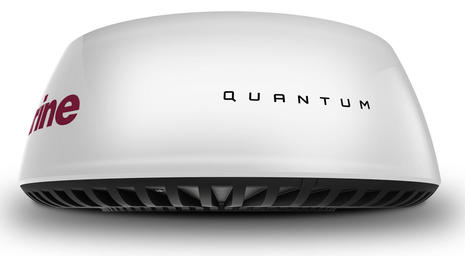 Wow, Raymarine is kicking off the new marine electronics year in grand style. Debuting today online (and at the New York Boat Show) is the Quantum Q24C solid-state radar seen above. While Ray apparently managed to keep this product a deep secret — I only heard about it yesterday afternoon — it appears to be thoroughly developed and near ready to ship. In fact, you’ll see that the install manual is already available, and I understand that the production line is rolling, with first deliveries expected around the time of the Miami Boat Show. I won’t get to see Quantum 24-mile CHIRP radar in action until then, but I was definitely impressed with yesterday’s briefing…
Wow, Raymarine is kicking off the new marine electronics year in grand style. Debuting today online (and at the New York Boat Show) is the Quantum Q24C solid-state radar seen above. While Ray apparently managed to keep this product a deep secret — I only heard about it yesterday afternoon — it appears to be thoroughly developed and near ready to ship. In fact, you’ll see that the install manual is already available, and I understand that the production line is rolling, with first deliveries expected around the time of the Miami Boat Show. I won’t get to see Quantum 24-mile CHIRP radar in action until then, but I was definitely impressed with yesterday’s briefing…
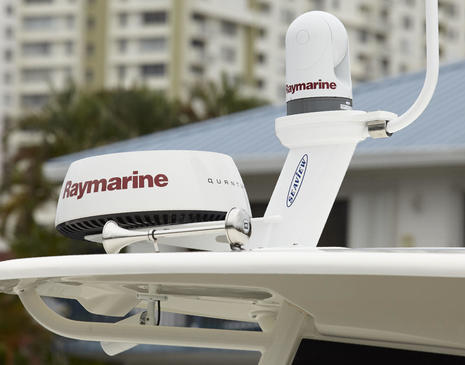 The $1,599 Quantum radome is obviously a direct competitor to Navico’s Broadband radome series, like the Simrad 3G and 4G (as well as all the other small magnetron radars in the market). But instead of using Broadband’s FMCW solid-state technology, Quantum uses CHIRP pulse compression transmissions more similar to Simrad’s Halo open array radars. Notice, for instance, the difference in proportions between the Quantum and Broadband antennas, which is because pulse compression uses a single transmit/receive array versus FMCW’s taller dual array. In fact, Quantum is almost the exact same dimensions as Ray’s existing “18 inch” radars, though it sports a sharp new industrial design and only weighs 12 pounds.
The $1,599 Quantum radome is obviously a direct competitor to Navico’s Broadband radome series, like the Simrad 3G and 4G (as well as all the other small magnetron radars in the market). But instead of using Broadband’s FMCW solid-state technology, Quantum uses CHIRP pulse compression transmissions more similar to Simrad’s Halo open array radars. Notice, for instance, the difference in proportions between the Quantum and Broadband antennas, which is because pulse compression uses a single transmit/receive array versus FMCW’s taller dual array. In fact, Quantum is almost the exact same dimensions as Ray’s existing “18 inch” radars, though it sports a sharp new industrial design and only weighs 12 pounds.
So Quantum has the general benefits we’ve seen so far from all recreational solid-state radars, like very low power draw (17W on, 7W standby, 2W sleep), nearly instant startup anyway, and virtually zero dangerous emissions. But we shouldn’t make presumptions about performance based on past Navico solid-state radome experience, because the specific solid-state tech is quite different. That said, Quantum performance looks good from what I’ve seen so far.
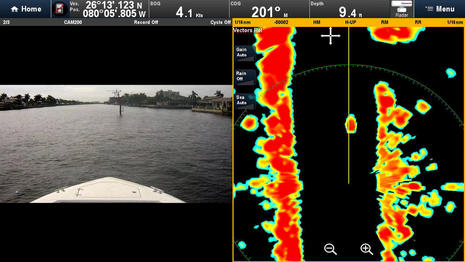 Here’s Quantum set at its minimal 1/16nm range — equal to about 380 feet or 115 meters — nailing a daymark roughly 190 feet ahead. Raymarine claims 18 feet as a minimal target distance and I think that’s plenty good enough. Note the very clean target imagery here and below, all with gain and sea clutter controls set on auto, and also how the test boat’s Cam200IP visual light camera (discussed here) can pair neatly with the radar, as could the thermal camera. That boat has eyes!
Here’s Quantum set at its minimal 1/16nm range — equal to about 380 feet or 115 meters — nailing a daymark roughly 190 feet ahead. Raymarine claims 18 feet as a minimal target distance and I think that’s plenty good enough. Note the very clean target imagery here and below, all with gain and sea clutter controls set on auto, and also how the test boat’s Cam200IP visual light camera (discussed here) can pair neatly with the radar, as could the thermal camera. That boat has eyes!
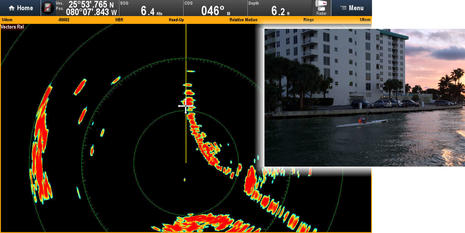 Here’s the test boat in Indian Creek, Florida, with the Quantum set at the 1/4nm range more commonly used in tight waters. Apparently, that’s the photo boat trailing close behind, but more impressive is the small target showing along the shoreline off the starboard bow. It’s that kayaker in the photo, which also shows how he was paddling in front of a large concrete building that might have messed up his slight return signal on a conventional radar. The kayak represents the high range resolution possible with CHIRP pulse compression and FMCW solid state radar, and Quantum also claims “FLIR’s exclusive ATX advanced target separation technology” (which may be like 4G and Halo’s beam sharpening).
Here’s the test boat in Indian Creek, Florida, with the Quantum set at the 1/4nm range more commonly used in tight waters. Apparently, that’s the photo boat trailing close behind, but more impressive is the small target showing along the shoreline off the starboard bow. It’s that kayaker in the photo, which also shows how he was paddling in front of a large concrete building that might have messed up his slight return signal on a conventional radar. The kayak represents the high range resolution possible with CHIRP pulse compression and FMCW solid state radar, and Quantum also claims “FLIR’s exclusive ATX advanced target separation technology” (which may be like 4G and Halo’s beam sharpening).
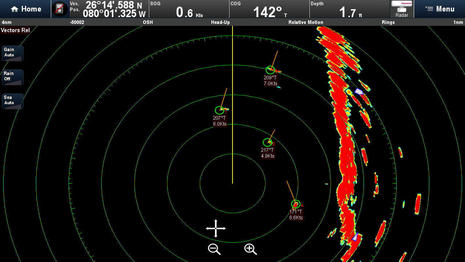 Now the boat is laying off the Florida coast with four MARPA targets selected and locked in at 4nm range. Small radar MARPA on small boats can be flaky, and screenshots rarely tell the full story, but those target speed and heading calculations look credible to me.
Now the boat is laying off the Florida coast with four MARPA targets selected and locked in at 4nm range. Small radar MARPA on small boats can be flaky, and screenshots rarely tell the full story, but those target speed and heading calculations look credible to me.
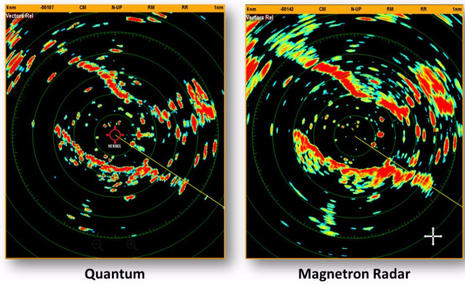 I wish I could share high resolution screens of Quantum at 6nm range, but like this low res comparison nontheless. I believe it was taken somewhere on the south coast of England, probably aboard the mighty Raymariner, and it compares Quantum to Ray’s conventional (and excellent) 18-inch 4kW radar in busy waters. The CHIRP pulse compression seems to returning nearly the same hard targets out at the margins with perhaps a bit more detail in close. Note also the lack of interference from other radars.
I wish I could share high resolution screens of Quantum at 6nm range, but like this low res comparison nontheless. I believe it was taken somewhere on the south coast of England, probably aboard the mighty Raymariner, and it compares Quantum to Ray’s conventional (and excellent) 18-inch 4kW radar in busy waters. The CHIRP pulse compression seems to returning nearly the same hard targets out at the margins with perhaps a bit more detail in close. Note also the lack of interference from other radars.
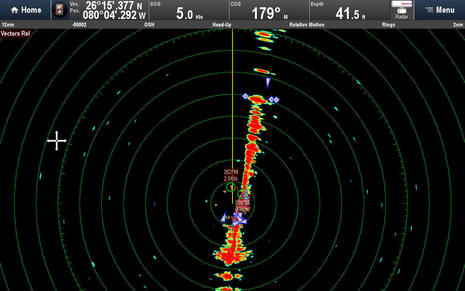 Finally, here’s another coastal shot, this time at 12 nautical mile range. Navico’s early Broadband radar was decidedly weak at ranges like this, though that improved greatly with the 3G and especially the 4G model. Quantum looks good here — note the strong return at 16nm — and Raymarine’s Jim McGowan told me that he’s seen good ship and coastline imagery at nearly 24nm, and also that Quantum can see rain well in Weather Mode (or filter it out). But when you’re using 20W solid-state pulses to do what’s normally done with 4kW magnetron pulses — as Quantum does — folks need more assurance that they can really make the distance. I’d like to see more screenshots or, better yet, try it myself.
Finally, here’s another coastal shot, this time at 12 nautical mile range. Navico’s early Broadband radar was decidedly weak at ranges like this, though that improved greatly with the 3G and especially the 4G model. Quantum looks good here — note the strong return at 16nm — and Raymarine’s Jim McGowan told me that he’s seen good ship and coastline imagery at nearly 24nm, and also that Quantum can see rain well in Weather Mode (or filter it out). But when you’re using 20W solid-state pulses to do what’s normally done with 4kW magnetron pulses — as Quantum does — folks need more assurance that they can really make the distance. I’d like to see more screenshots or, better yet, try it myself.
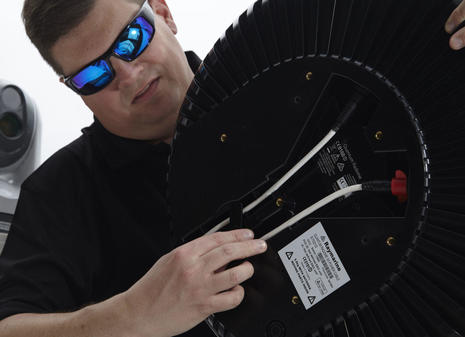 Meanwhile, Quantum mechanics (ha!) are easier to judge. That’s McGowan above showing off the radome’s sculpted bottom design — “We realized that the bottom was what many radar owners see the most” — and clever install details. For instance, the cable retainer he’s touching is spring loaded so the installer doesn’t have to use little fasteners while precariously up a mast.
Meanwhile, Quantum mechanics (ha!) are easier to judge. That’s McGowan above showing off the radome’s sculpted bottom design — “We realized that the bottom was what many radar owners see the most” — and clever install details. For instance, the cable retainer he’s touching is spring loaded so the installer doesn’t have to use little fasteners while precariously up a mast.
The Quantum uses separate power and Ethernet cables that can either be run out the back or down through a hollow mount. There’s also a short adapter cable so that a boat with Raymarine’s current single (combined power/Ethernet) radar cable already rigged can use it with a replacement Quantum. (Plus, there’s a single power cable and Wi-Fi install option to be discussed further down!)
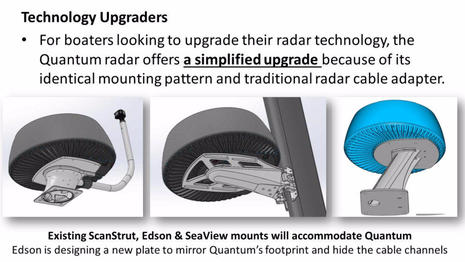 Obviously, Raymarine designed Quantum for easy retrofitting, though I must note how nice the new radome design looks with Edson’s specially designed mount plate even though an existing Edson Ray plate will work.
Obviously, Raymarine designed Quantum for easy retrofitting, though I must note how nice the new radome design looks with Edson’s specially designed mount plate even though an existing Edson Ray plate will work.
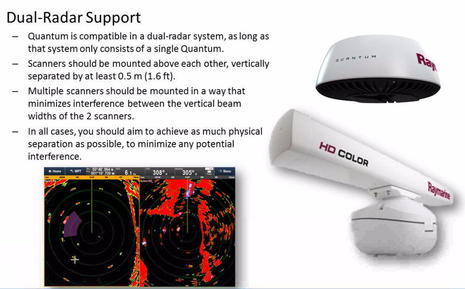 Then again, some boaters may want to add Quantum to an existing Ray radar install, even an 18-inch 48-mile model. That’s because Quantum does not offer dual ranges or rotation speeds greater than 24 rpm but purportedly does play nicely with a magnetron radar, which will also likely have long-range strengths that nicely complement Quantum’s shorter range abilities. (Quantum can detail a marina or mooring field quite nicely, though the screenshots that best illustrate this don’t seem to be online yet.)
Then again, some boaters may want to add Quantum to an existing Ray radar install, even an 18-inch 48-mile model. That’s because Quantum does not offer dual ranges or rotation speeds greater than 24 rpm but purportedly does play nicely with a magnetron radar, which will also likely have long-range strengths that nicely complement Quantum’s shorter range abilities. (Quantum can detail a marina or mooring field quite nicely, though the screenshots that best illustrate this don’t seem to be online yet.)
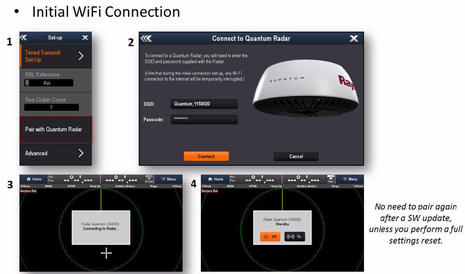 Finally, the Quantum is the first radar ever with the choice of WiFi or Ethernet data connections (the Furuno DRS4W is WiFi and iPad only), and the WiFi option looks to be smartly done. The briefing slide above shows how easy it is to log an MFD running Lighthouse 16 (coming soon) onto a Quantum’s WiFi, and note how the warning implies that an existing MFD Internet connection will only be interrupted temporarily. Jim McGowan further explained that a Quantum is even able to “fail over” to another MFD if the originally logged-in one goes caput (or isn’t turned on).
Finally, the Quantum is the first radar ever with the choice of WiFi or Ethernet data connections (the Furuno DRS4W is WiFi and iPad only), and the WiFi option looks to be smartly done. The briefing slide above shows how easy it is to log an MFD running Lighthouse 16 (coming soon) onto a Quantum’s WiFi, and note how the warning implies that an existing MFD Internet connection will only be interrupted temporarily. Jim McGowan further explained that a Quantum is even able to “fail over” to another MFD if the originally logged-in one goes caput (or isn’t turned on).
And, yes, a LightHouse MFD connected to Quantum WiFi can still be an access point for various Ray apps, as Jim illustrated below. “But isn’t that a terrible radar image,” I said before noticing the apology line. Heck, that’s Quantum radar imaging everything that’s within the four walls of Raymarine’s U.S. headquarters in New Hampshire. The company is clearly excited about their new radar, and so am I. It looks like a great new option for those who have or are about to purchase Ray navigation systems, especially sailors, and it’s good news to finally have competition in solid-state radar, with Quantum possibly just the first we see in 2016.



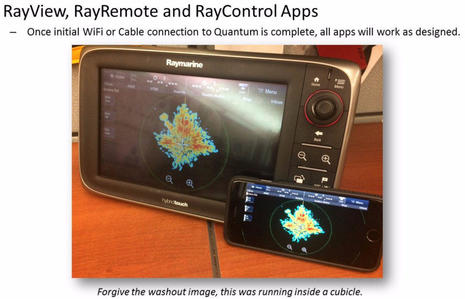
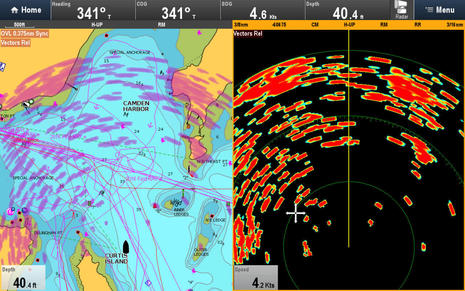










I’m actually surprised that the others left Navico an empty playing field for so many years. Here in the Netherlands I’ve seen a dramatic upswing in Navico market share amongst sailors because of broadband radar.
Quantum tech does sound comparable to Halo.
Now let’s see if Furuno & Garmin will follow suit.
Looks very impressive and considered. I do like some of the design details. At last a company has spent some time on the visual look of a Dome.
The fitting and the specification sound top notch, really looking forward to see this at the next boat show.
A practical detail about the new radome design is that the cover apparently laps over the bottom piece in such a way that waterproofing is easy. I was also told that Quantum will be shown not only at the New York Boat Show but also the Toronto Boat Show and the London Boat Show, both coming up soon, and then there will be a grand showing in Miami starting February.
Another detail about the radome design is that the FLIR double- chevron logo is embossed on the top. Apparently we will see this in future Raymarine designs as FLIR slowly “owns” the brand. That’s a skillful dance to watch as FLIR seems to be maintaining good thermal camera integration relationships with all the other major brands at the same time.
Thanks for the write up Ben.
Do you think Raymarine will come out with an open array using this same technology?
It would be interesting to see the longer distance version, low power out aspects that Halo has.
I am also very interested to hear how it’s Marpa works out.
Ben, do you know if the signal Quantum is transmitting is similar to a single pulse from a magnetron radar except it’s replaced by a CHIRP or if it’s sending out a burst of signals? Halo can transmit up to one pulse (very short) and five CHIRP’s in one burst. This is the way Halo get optimum resolution at all ranges, the image is a combination of a large number of separately processed returns which are merged at the end.
Quantum looks like a very interesting product, I had RD418HD before swapping to a Simrad system with 4G so I know the two radars it will be bench-marked against very well.
A bit disappointing that 48rpm and dual range are not supported. I have not seen anything about programmable beam sharpening like what Simrad is offering, based what I’ve seen of examples so far the beam seems wider than the 4G at the narrowest setting.
It’s good that the competitors start to catch up when it comes to solid state radar. I’m quite sure this will bring forward the introduction of an improved 4G or a dome version of Halo.
I have the Raymarine 4kw HD radome and near latest chart plotter. I am just fine with it, but it could be compelling if the difficulty level for new users is vastly reduced.
Do you have any impressions Ben, based on the other brands, if the solid state technology will reduce the difficulty level for novices to use radar over the previous generation of Raymarine?
I agree to Kees, many sailors also in germany switched to Navico products. On the other side we have got a lot of Raymarine OEM installations or people that meanwhile installed the excellent Raymarine Evolution Autopilots and are looking forward for manufacturer homogene and redundant systems. At this moment I wonder if the scanner also would work without a Raymarine MFD just using on of their smartphone oder tablet apps. The big advantage with the presentation of Quantum Q24C is, that it is not only an announcement, they already have the units in stock, even in europe, so that we will have our 1st unit on next monday
Thank you Ben for noting Seaview as a Quantum radar mounting option. That Seaview dual mount sure looks nice with the Quantum radar!
Compared to other 18-24″ Raymarine radars this Quantum radar mounting hole center line changed, however our modular design will accommodate this change as if we were ready for this! 🙂 All of our mounts not only work with the Quantum, but the dome can mount properly centered and still tight to the mast when using the Seaview mast mount.
Our updated Raymarine specific catalog can be found online at http://www.seaviewglobal.com/system/attachments/Raymarine_Catalog__low_res_.pdf
This is a game-changer for Navico, but it does not surprise me since FLIR took over the reins of Raymarine.
I’ve been waiting for this…I’m not a huge cheerleader for Lowrance or Simrad, yet need both close-range radar and the ability to run Navionics charts.
I expect an improved model will be introduced by Raymarine within 6 months, after they work any bugs out that need more than a firmware upgrade. Glad the monopoly is finally over for those of us who need safe, close-up radar, and glad it was Ray that did it rather than Garmin, which has traditionally had a hostile relationship with Navionics.
It seems 2016 maybe the hear of solid state recreational radars !
Raymarine obviously have done a good job not only developing a product but having a shipping product at launch (who does that anymore!)
Anyway many years since Kelvin Hughes introduced SharpEye it seems the magnetrons days (appear) to finally be numbered.
I wonder if Honeywell ever passed over their tech to some of these players as discussed back in 2008
https://panbo.com/archives/2008/11/honeywell_pc_ss_radar_wow_again.html
or if these guys developed in house…
Flir has a lot of experience with solid state radar for ground surveillance, they are using both FMCW (as the 3G and 4G) and pulse compression.
http://www.flir.com/surveillance/display/?id=64731
I’ve heard rumors they also looked into FMCW for a Raymarine solid state radar, but concluded it would be very challenging.
I, too, have wondered whether it was a patent/licensing issue, or simple disinterest in competing with Navico, but FLIR obviously found a solution that ended the Navico strangle-hold on solid-state broadband dome radars, actually approaching the more expensive Navico HALO system, at a lower admission charge.
BUT, let’s not forget that Garmin has recently been found by the ITC of violation of two Navico patents (regarding sonar technology), involving DownScan vs. DownVu, and Garmin was issued a cease and desist order, but still has appeals left, but as of now, there has been no stay of that order.
So, I guess, stay tuned…hope Ben will follow this potential legal issue and report. Navico can be a pit bull in protecting intellectual property.
My understanding is that Quantum is aimed at the low end and is targeted to be better than Navico 3G/4G (ideal for sailboats, small motor boats). On the high end we will continue to see the HD, high power radars, though.
I am really excited about the radar as I spend the last three weeks planning how to transition from a Raymarine setup to a B&G setup, now I just need to get the Quantum.
Vassil
Since Quantum don’t support 48 rpm and dual range it seems to be aimed at competing with the 3G. I expect to see an upgraded model within short time.
Quantum don’t have much in common with Halo except the use of solid state pulse compression technology. Quantum is a “standard” implementation of a pulse compression radar without a lot of fancy functions. It looks like a dome implementation using similar technology as the JRC solid state radar introduced in 2008. But nothing wrong with this and I expect it to be a solid performer.
For what it’s worth, I was at the Raymarine exhibit at the London boat show today. In chatting with one of the senior people from their headquarters, I got the very strong impression that new versions of their open array radars are not far behind. Speculation, but might be timed for Miami boat show next month.
Also in the rumor department, Garmin guy gave me impression an updated version of the 8000 series is coming along very soon. That makes a lot of sense as the 8000 was leapfrogged by the 7600 in screen resolution and other features and cannot really sustain its “premium” positioning.
I believe that your not correct in your thinking. Novice 3G is not just what this radar is supposed to compete against. Rather, this very exciting Radar is finally the wedge that will drive people away from Navico, by offering a superior product that WILL evolve. Now there is an alternative that will give present, and more importantly, future customers a reason to keep buying Raymarine. There are a ton of people that call Raymarine their brand!
Raymarine has systematically chipped away at everything that was exclusive to Navico.
Jerry, this radar don’t have the functionality expected by a top tier dome radar. 48 rpm and dual range radar are missing, Raymarine have offered this themselves since 2010 with the HD domes. I would not consider a radar not supporting dual range. I had RD418HD prior to the 4G so I’ve been running dual range for close to six years now.
I’ve written above that I expect to see an upgraded model fixing these shortcomings soon.
If the Quantum radar is very good I expect to see Navico responding with an upgraded dome in near future. I’m sure they know how to improve the Broadband radar and they can of course also build a dome version based on Halo technology.
The integrated sounders offered by Raymarine are like a joke compared to Garmin and Navico. CHIRP without low Q-factor transducers doesn’t make sense. So Raymarine has still a way to go to be competitive for large parts of the sports fishing market.
I question the value of the dual range feature that was left out. Does anyone really use the dual range anyhow? When using dual range on my Raymarine the chart sync and MARPA features go away and so much of the MFD real estate is used up having two radar windows.
Dan, I couldn’t agree more!
Truth be told, most of the time I use the “auto” under speed control and while at or under the 6 mile scale, It increases to 4800 rpm (vs 2400 rpms) for fast target acquisition. Of course, that turns off the dual range option, but I never use it anyway. If this new Spectrum radar performs as good as advertised, I can’t imagine the necessity to speed it up anyway.
I apologize to arbor. I din’t mean to strike a nerve. I just don’t think Raymarine is done yet, by a long shot!
One of the main reasons I appreciate the Raymarine brand, is that they aren’t the brand that changes plotters every other year! I’d rather have simple modules that can connect to all the MFD’s. It certainly make it easier to “upgrade”. Too many fishing friends are fed up wth Navico and Garmin discontinuing their plotters for models that are exclusionary when it comes to connectivity. Their plotters are only 1.5 years old!
Let’s note that dual range radar varies greatly from brand to brand and even model to model. For instance, the Simrad 4G variety I like a lot does not limit chart overlay or MARPA at all. In fact, if you want, you can have 4 radar windows, two regular with completely independent settings, and two chart windows with each range overlaid. Like some other dual range implementations, 4G may somewhat lose “energy on target” — especially if the ranges are extremely different — but Simrad claims to have solved that issue with Halo’s simultaneous multi-length pulse bursts.
I’m heading to the London boatshow tomorrow and had my credit card at the ready until……I downloaded the manual and see that it’s not compatible with my 4 year old C90W. So to buy this I’d have to upgrade my plotter and work out how to connect my seatalk-1 autopilot and perfectly good seatalk instruments to one of their lighthouse thingies. Perhaps I can manage without radar a bit longer…
Bad luck, Keith, but hopefully you got a good discount on the C90W. It was 4 years ago this month that the c90 was announced:
https://panbo.com/archives/2012/01/wow_raymarine_e9_e12_c9_c12_clearpulse_voyageplanner_all_new.html
Until last year I had a Raymarine E-80 I purchased in 2006 (at that time the E series was top of the line) and was thrilled that Raymarine provided software upgrades for it to support Weather (~2009), AIS (~2010), HD Radar (~2013), new auto pilot & sensors (~2014), and many revisions to N2K.
“That’s McGowan above showing off the radome’s sculpted bottom design — ‘We realized that the bottom was what many radar owners see the most’ ”
Good for them for realizing this, but I don’t think they came to the right design solution. It’s one thing to have the radome installed on top of a hardtop, as in your first photo. But it’s another thing to have it on a sailboat — where a black disk overhead would be both ugly and distracting.
Kudos on the technology, tho’. We installed a new Ray system last year…..maybe by the time we’re ready to upgrade the units will be all white!
https://m.youtube.com/watch?feature=youtu.be&v=S4lhpz-3mrE
Furuno NEW radar coming soon. My experience says it will outperform the rest
DRS4D-NXT seems a possible part number
What is a DRS6A X-Series though **hopes**
http://www.furuno.com/files/Brochure/318/upload/DOCQA9015_4_RoHS.pdf
Really the black underside bothers you, if it works as advertised the under color is irrelevant.
Thanks, Navigator. That Furuno video is a real tease, and I hope to learn more about NXT radar next week in Miami
Wow, solid state marine radar is busting out…
https://panbo.com/forum/2016/02/furuno-to-unveil-new-radar-and.html
I tested my first mounted Quantum yesterday and I must say I’m impressed. I mounted quit a lot of radars also 4G and 3G from navico the radars were we can compare with I think . but comparing the Quantum with the 3G is not an option because of the range , the 4G comes closer but in larger range the Quantum wins by far. I connected is by wire (no WIFI0 through a network switch to an Es127 and also on board a evolution autopilot who should provide a fast heading I think but overlay was slow and going al over the screen (or the processor in the Es127 because you need a lot patience) . don’t think it is fast enough for a rib or something like that. but for sailors it is a good radar also on larger ranges what I didn’t expect.
Wow, there’s now a WiFi only Quantum solid state radar retailing for $1,300!
I fear a little confusion about it, however. Even the Raymarine guys I’ve been fishing with didn’t realize that it was out in the market already and there’s nothing about it on the Raymarine site yet.
Plus it’s not clear at some online store sites that the Quantum Q24W (part # E70344) is different from the Q24C described above (part T70243 with a 10m Ethernet data cable, E70210 without).
WMJ does a good job of clarifying “No wired data connection”…
http://www.wmjmarine.com/e70344.html
…but West Marine not so much:
http://www.westmarine.com/buy/raymarine–quantum-wireless-chirp-pulse-compression-24-nautical-mile-radar–17348350
And only Boatersland mentions the new “Q24W” model name:
http://www.boatersland.com/raymarine-quantum-q24w-18-wifi-only-with-10m-power-cable.html
But I’m sure this will get straightened our quickly and the real news is decent solid state radar with interesting future update possibilities at an attractive price. And it should be simple to install unless you have some sort of WiFi interference onboard or the if there’s too much “stuff” between the Quantum and the paired WiFi MFD.
My bit of Quantum demo experience here:
https://panbo.com/archives/2016/02/solid_state_radar_1_long_ranges_and_deep_thoughts.html
The Quantum Q24W WiFi-only radar is official. It’s now listed under the Ordering Info tab here…
http://www.raymarine.com/content/?id=13531
…and it’s included in the manual you can also find on the Quantum site. I’ve seen a dealer memo that went out today saying that the Q24W will ship by the end of May (like now) and that its MAP price is $1,300.
I ordered the Es78 and quantum radar package on sale at west marine on 5/21/16
They say now it won’t ship till 6/16/16 as they are on back order.
Has anyone been sucessful in purchasing and actually receiving the t70261 package.
It looks like Raymarine / FLIR have done a deal with Humminbird
http://www.humminbird.com/Products/HB2124/
The HB2124 looks very similar to a Quantum & the FCC lets the cat out of the bag
https://fccid.io/document.php?id=3136111
Thanks. I mentioned this news in a recent solid state radome overview…
https://panbo.com/archives/2016/12/testing_the_garmin_fantom_24_in_a_new_world_of_solid-state_radar.html
…but I didn’t realize that Humminbird was out with the news. I notice that so far the WiFi data interface is not supported by Humminbird but maybe that will happen with future updates or new model MFDs. At any rate, I think it’s great that the 5 biggest brands now offer solid state, and fine that only 4 of them are doing their own development.
Raymarine just announced Quantum 2, with Doppler functionality.
can the Quantum Q24C work with a Humminbird ION unit? Assuming you can connect with the ethernet connection on both. It is the same unit as Humminbirds but $300 cheaper.
they appear to be the same however, it is possible the software is different between the units.
Anon #1, Anon #2 is correct; there’s no telling if the software is the same in the Raymarine and Humminbird versions of the radar. I guess you could try mixing them, but it may not work.
Quatum 2 Doppler details here:
http://www.raymarine.com/marine-radar/quantum2/
We got a demo of a prototype in Miami which looked pretty good in terms of moving target identification, screenshot here:
https://panbo.com/assets_c/2018/02/Raymarine_Quantum_2_Doppler_radome_in_Miami_aPanbo-16165.html
Note that Q2 includes ARPA (like Furuno) and true trails, and that MARPA has purportedly been improved for all the Ray radars.